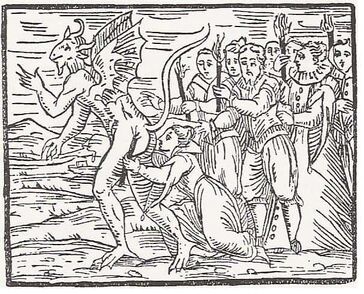This is a "Way to Die" I made through ancient history. Hope you like it!
Plot[]

Vox in Rama
Konrad's early life is not well known, but he was described by contemporary church sources as well educated and highly knowledgeable. It is possible that he received a university education. He was also noted for his strong asceticism and his oppressive zeal in defending the church. Konrad long was considered to have been a member of the Dominican Order, but modern scholarly consensus holds that he was not.
Much of his early work within the church was related to the suppression of heresy, and he took an active part in the Albigensian Crusade in southern France. Pope Innocent III, who championed the Medieval Inquisition, was one of Konrad's early supporters. Eventually, however, Konrad returned to Germany, the land of his birth. He gradually acquired a position of considerable influence at the court of Louis IV, Landgrave of Thuringia. In particular, Konrad was employed by Louis' wife, St. Elizabeth of Hungary, to whom Konrad acted as spiritual director.
After receiving a commission from the Archbishop of Mainz, Siegfried II, Konrad set to work seeking out heresy in both Thuringia and Hesse, and quickly gained a reputation for being unreasonable and unjust. According to most accounts, Konrad accepted almost any accusation as true, and regarded suspects as guilty until proven innocent. Those accused of being heretics were quickly sought out by Konrad's mobs, and told to repent or else be burnt at the stake. Those accused of heresy were also encouraged to denounce others, with the implication that their own lives might be spared if they did so. Konrad included commoners, nobles and priests in his inquisition: Heinrich Minnike, Provost of Goslar, was one of Konrad's first targets, and was burnt at the stake.
On June 13, 1233, the Pope issued the Vox in Rama to King Henry of Germany. The bull began by bewailing the various woes that afflicted the church- the most recent being the satanic cult identified by Conrad of Marburg as flourishing in Northern Germany. The bull called upon the bishops of Mainz and Hildesheim to lend Conrad their full support in rooting out these witches. It also provided a remarkably full account of their Satanic rite. This description created an image that was to be used for all future depictions of witches’ sabbats- and one that established the cat as a creature of the devil.
The account began by describing the initiation of novices to the coven. Firstly, they are greeted by an abnormally large frog or toad, whose behind they must kiss and then a “man of fearful pallor” and thinness whose task was to suck out “every last remnant of faith in the Catholic Church” from their soul. The novice then feasted with the rest of the congregation, after which they assembled to pay homage to “a black cat” which emerged “ from a kind of statue which normally stands in the place where these meetings are held.”
The whole coven was required to kiss the cat’s behind, and once they had done this, a wild sexual orgy occurred. Once the lights came back on, “from a dark corner, the figure of a man emerges.” This ‘man’ was Lucifer, who the whole company firmly believed to have been wronged by God. As was to be expected of a former angel “The upper part of his body from the hips upward shines as brightly as the sun.” However, his fall from grace was encapsulated by his lower body where “his skin is coarse and covered with fur like a cat.”
The Vox in Rama encouraged Conrad of Marburg to overreach himself and that same year he accused Henry II, Count of Sayn of taking part in satanic orgies. Henry was acquitted when he appealed to the bishop of Mainz and later that year Marburg himself was mysteriously murdered- probably at Henry’s behest. In the meantime, accusations of witchcraft began to spread amongst the ordinary people, as a way of settling grudges or seizing property and cats began to be used as proof of satanic association.
No one can say for sure how many cats were killed because of the association made between them and witchcraft by the Vox in Rama. However, historian Donald Engel believes that the Vox acted as a death warrant for the cat. Indeed the belief that the torture or killing of cats could break spells continued across northern Europe. Denmark’s Fastelavn held at the start of lent was based on the premise that for spring to begin, evil had to be banished. That evil came to be neatly personified in the form of black cats that were beaten to death to purge the new season of evil spirits.
Elsewhere in Europe, the legacy of cat killings passed into folk practices. Cat burning became a favorite medieval pastime in France, where cats were suspended over fires in cages or doused and set alight- even chased on fire through the streets by cat chasers. In Ypres in Belgium, it was the custom to hurl cats from the belfry of local churches and then set them on fire during the festival of cats or Kattenstoet. This cruel practice continued until 1817 although the Kattenstoet continues to this day- involving stuffed cats instead.
In 1227 Pope Gregory IX commissioned Konrad to eliminate heresy throughout the whole of Germany, granting him permission to ignore standard church procedure for the investigation of heresy. The pope also issued the papal bull Vox in Rama in response to Konrad's allegations, condemning Luciferian, and in 1233, Konrad accused Henry II, Count of Sayn, of taking part in "satanic orgies". Henry, however, appealed to an assembly of bishops in Mainz where they decided to postpone a verdict to the discontent of both parties.
Konrad, refused to accept the decision and demanded that a verdict be reached, but eventually gave up and left Mainz to return to Marburg. On the road, he was attacked by several knights, who killed both Konrad and his assistant, a Franciscan friar named Gerhard Lutzelkolb. The knights may have been in the service of Henry.
After Konrad's death, Pope Gregory declared Konrad to have been an upholder of the Christian faith and ordered his killers punished. Perceptions in the German Empire, however, were markedly less favorable, and the memory of Konrad was enough to turn opinion against the Italian Inquisition for many years. Not only locally, and not diminishing over the centuries, the name of Konrad von Marburg became a byword for sadism and the dark side of Catholicism.
Konrad wanted to cleanse the Earth of Satan's power, but in reality, he wound-up making God his Pagan bitch. In the end, Konrad paid for his sins... in blood. Auf wiedersehen, Dummkopf.
Interviewees[]
- Bishop Franz-Josef Overbeck (Church Official).
- Dr. Dragan Primorac (Forensic Scientist)

